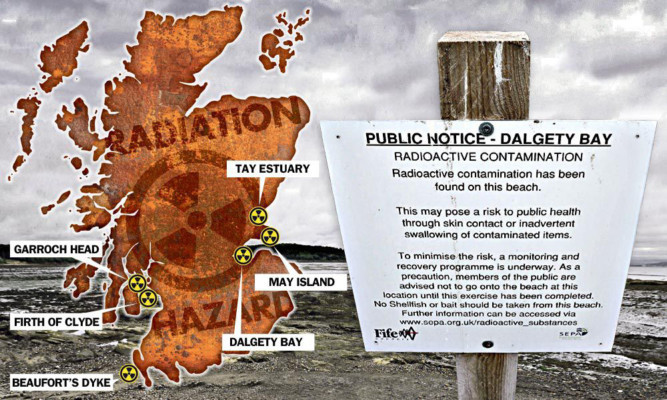
The full scale of how much radioactive waste has been dumped in Scotland’s seas can today be revealed for the first time.
A Sunday Post investigation has uncovered documents which show more than 75,000 luminised dials coated with radium were tipped into the Tay Estuary after the Second World War.
Archive files from the 1950s also reveal how radioactive waste from a Dundee radio valve plant was secretly dropped into the waters below the Forth Bridge, less than a mile from a radium-contaminated beach at Dalgety Bay in Fife.
The archive files also show other dump sites around Scotland and how waste and sludge from nuclear submarines based at Rosyth Dockyard was regularly being deposited in the Firth of Forth during the 1960s.
Green MSP Alison Johnstone said: “Scotland’s environment has for too long been treated as expendable rather than as a precious resource. These historic incidents must be properly investigated by regulators so we know the extent of the damage.
“It’s galling the private firms responsible for dumping no longer exist, making it hard to pursue the polluter for clean-up costs. But where these incidents have been carried out by public bodies or sanctioned by them, they should be held accountable for such reckless behaviour.
“Scotland’s land and water are vitally important and remain under threat. We must establish the impact of historic dumping and it should serve as a reminder that risky actions can leave a damaging legacy.”
Documents at the National Records of Scotland show the now-defunct electronics firm Ferranti Ltd dumped scrap from its Dundee radio valve manufacturing plant in the Firth of Forth, by the rail bridge in North Queensferry, every three or four months between 1954 and 1956 without permission.
Minutes from a Government meeting in 1957 show how national chief chemical inspector Eric Birse concluded Ferranti “had simply decided on their own that it would be a good place for dumping”.
Documents show “five batches of radioactive materials were disposed of between 1954 and 1956”, but Mr Birse is on record as saying he doubted the accuracy of the firm’s calculations.
During a visit to the Dundee plant in October 1956, the Radiological Protection Service told Ferranti “the quantities involved could well present a hazard and that you should obtain approval for your dumping point and quantities to be dumped”.
The dumping spot is close to the beach in Dalgety Bay which has been closed because of radium contamination.
The beach was used to break up to 800 planes after the Second World War and the contamination there is thought to come from the instrument dials on the aircraft which had been illuminated by paint containing radium.
The Scottish Environment Protection Agency last year blamed the MoD for the contamination, which is being released as the headland erodes.
However, defence chiefs have disputed its findings.
Documents at the National Records of Scotland show how the now-defunct Dundee firm UK Time a forerunner to the well known Timex firm arranged a deal with local fishermen to put 35,000 luminised dials coated with radium into drums and dump them in the Tay Estuary in 1949.
The arrangement, according to Scotland Office papers, continued for a further eight years at an estimated 5,000 dials a year before dumping was then switched to the UK Government’s official site at Beaufort’s Dyke.
A 1997 National Radiological Protection Board report, released under freedom of information laws, also details how other sites around Scotland were used for the authorised dumping of radioactive waste.
The now-defunct ICI Ltd disposed of radioactive waste from its Ayrshire explosives
factory in the sea off the Isle of Arran in 1958.
Five years later, waste from an old radium factory at Balloch in Dunbartonshire was barged down the Clyde and dumped at Garroch Head, off the Isle of Bute.
The NRPB report also details how the UK Government gave authorisation for liquids and sludges which contained the chromium, iron and cobalt radioactive waste from the refitting of nuclear submarines at Rosyth Dockyard to be dumped at sea.
The report says waste from the Fife naval yard was deposited to the east of the Isle of May in the Firth of Forth every three months from 1966.
However, the NRPB report concluded the health risks to the public from both the official and unofficial dump sites were low.
All of the incidents uncovered by The Sunday Post pre-dated legislation brought in to regulate the management of radioactive waste.
Dr Richard Dixon, director of Friends of the Earth Scotland, said: “This is a particularly alarming account of what has been dumped in our seas and I think there is enough evidence for SEPA to take a look at and investigate.”
A spokeswoman for SEPA said: “It’s well documented that radioactive waste has been disposed of historically to coastal areas around the UK, including areas of the Firth of Forth.
“In 1997, the NRPB undertook a review of historic dumping and assessed the consequences of various exposure routes and concluded that the potential harm from exposure to radioactive waste were low and also that additional environmental monitoring was not required.
“Monitoring for various radioactive sources, including radium-226, has, however, been undertaken by SEPA and various parties across the Forth for many years. To date, the results of this monitoring have not suggested that there has been any impact from these historic disposals.”

Enjoy the convenience of having The Sunday Post delivered as a digital ePaper straight to your smartphone, tablet or computer.
Subscribe for only £5.49 a month and enjoy all the benefits of the printed paper as a digital replica.
Subscribe